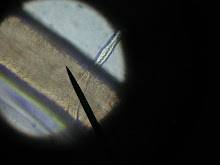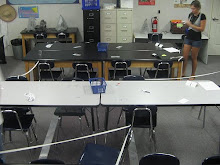Saturday, 29 August 2009
Fingerprint Types~
Posted by Tala Khatib at 12:13 0 comments
Monday, 24 August 2009
The History of Fingerprints~
Although the idea that no two fingerprints are alike was first discovered by various officials in 14th century Persia, it was not until 1858 that Sir William Herschel began using fingerprints as an identification process. Herschel began having locals sign contracts with their palm prints, because he believed leaving a print bound you to a contract more than a signature would. Later, Herschel began only using the thumb and the forefinger for contracts, and as he used this form of signature more and more, he began noticing that although there are basic designs for fingerprints, each print has its own distinct design. Furthermore, in 1882 by a man named Alphonse Bertillon discovered that fingerprinting can actually be used as way to catch criminals. Bertillon was the Chief of the Department of Judicial Identity in Paris, France. He used Anthropometry as a means of identifying criminals. Anthropometry is a science which uses an individual’s length of head, middle finger, left foot and forearm from elbow to tip of middle finger to identify whether or not someone is guilty of a crime. When Bertillon was introduced to using fingerprints as a means of identification, he used it but only as a secondary role in the category of special marks. Although, the more Bertillon’s’ fingerprint collection grew, the more he was able to learn about fingerprints. And as his knowledge grew, he noticed that every fingerprint is unique and using fingerprints is one of the most accurate identification techniques. Later, in 1891, Juan Vucetich, an Argentine Police official, made the first criminal identification using a bloody fingerprint in 1892. To conclude, in 1902 the use of fingerprints as an identification process was introduced in the United States. And since then, we have found many different techniques in finding the prints and we have made files of prints for every baby born in the United States. Today, Fingerprint Identification is a basic method used to identify
suspects in a crime.
Information:
Posted by Tala Khatib at 06:54 0 comments
Lifting Fingerprints~
Posted by Tala Khatib at 06:30 0 comments
Basic Fingerprint Shapes~
Although families may be genetically alike, their fingerprints are drastically different. While the parents may have plain arches and ulnar loops, the children may have an accidental whorl and double loop whorl. Every human being has their own set of unique fingerprints, and although you might have two fingers with plain whorls, they might not have very many similarities as one might think. Also, it is one out of sixty-four billion that two people have IDENTICAL finger prints.
Arches~
Arches are found in about 5% of the fingerprints seen. There are four basic arch patterns which are plain radial ulnar and tented arches. The plain arches have an even flow with no significant curves, the flow from one side of the finger to the other, leaving a wave at the end. Tented arches have significant up-thrusts in the middle, making the print look like a mountain.
Loops~
Loops are seen on about 60-70% of fingerprints. The three basic types of loops are radial, ulnar and central pocketed. The radial loop, named after the radius in the forearm, is a mountain like figure that curves to the left. Likewise, the ulnar
Whorls~
Whorls are seen on about 25-35% of fingerprints. There are three basic types of whorls, Double Loop, Plain, and Accidental Whorl. One characteristic that all of the whorls have in common is that they all have two or more deltas in the middle. The Double-Loop Whorl literary looks like two whorls, forming into one larger whorl. The Plain Whorl looks like a two or more ridges that usually make a complete circle around the two deltas. Lastly, the Accidental Whorl looks like a circle but with more lines, giving the circle a hidden look.
Posted by Tala Khatib at 06:17 0 comments
Friday, 7 August 2009
The Crime Scene~
The Cat Hair
The Note written by Mr. Michael Kelly
Mr. Michael Kelly and Ms. Kooladria Jones are found guilty of drug trafficking. Kelly, the owner of the crack, was dealing crack to his usual clients on a late Saturday night when Jones, a woman who rarely comes to Kelly to purchase crack, decides to buy half a pound of the crack. Apparently, Kelly’s selling price was firm at 500 dollars for half a pound. Jones, who wanted to buy it for 150 dollars, was outraged at the high price and grabbed the bag of crack as she ran towards the door holding her cat, Steffi, and the crack securely. Kelly pulls out his gun in rage and shoots Jones right arm. Jones then falls to the ground, she drops the crack, one of her earrings, and her left shoe, and Steffi runs away. Jones and Kelly escape but because of the blood, the shoe, the earring, and Steffi’s hair Jones left behind, the police were able to find her. Also, because Kelly left a note which stated, "Ha, ha, ha I love crack", and a fingerprint, police were able to identify Kelly as part of the case as well. Today Michael Kelly and Kooladria are doing their time in prison as well as community service.
Posted by Tala Khatib at 11:15 0 comments
Thursday, 6 August 2009
Links~
Fingerprint Types:
Posted by Tala Khatib at 16:09 0 comments










